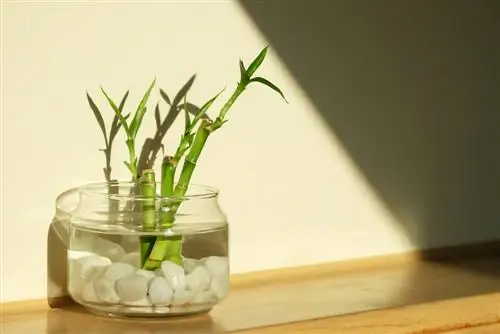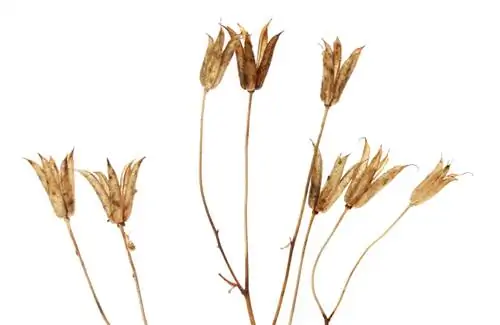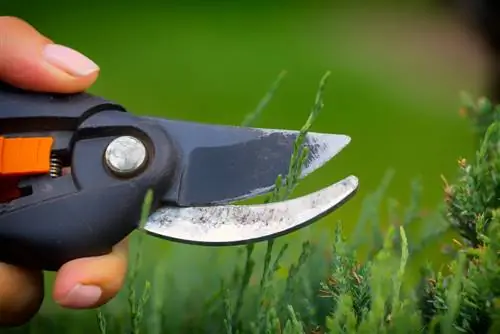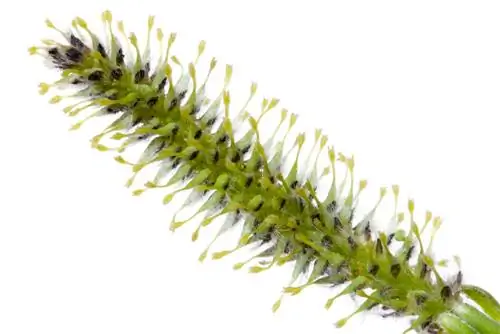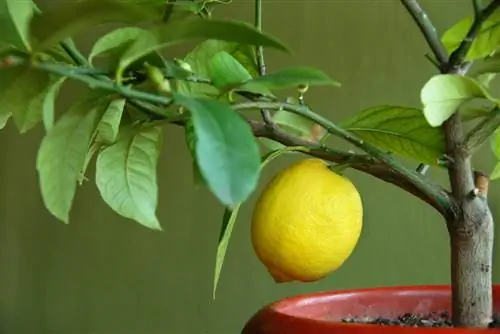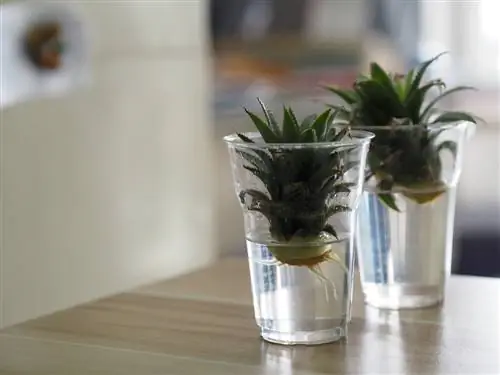- Author admin [email protected].
- Public 2024-01-15 08:07.
- Last modified 2025-01-23 11:21.
The lucky bamboo is a popular souvenir at New Year's Eve celebrations or other festivities. The plant holds many secrets. It can be cultivated in different ways and requires little care in the right location.
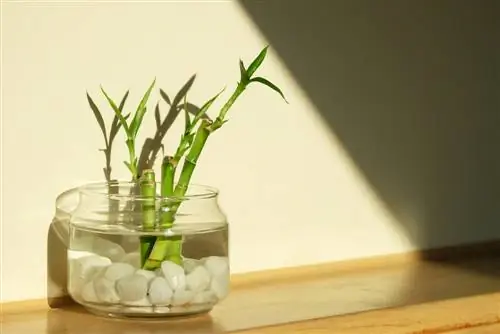
What does a lucky bamboo need for optimal growth?
The lucky bamboo (Dracaena braunii) is an easy-care houseplant that represents he alth and longevity. For optimal growth it needs a bright location without direct sun, regular watering and occasional fertilization. Yellow leaves usually indicate a lack of water or unsuitable irrigation water.
Origin
The original distribution area of the lucky bamboo is in Cameroon and tropical West Africa. Lucky Bamboo came to Europe in the 19th century, where the plant found admirers. The lucky bamboo has the Latin name Dracaena braunii, which indicates that it belongs to the dragon tree genus. The plant is therefore not bamboo, but rather related to the palm-like dragon tree. Other dragon tree species with similar growth habits are often offered as lucky bamboo.
leaves
Dracaena braunii develops evergreen leaves that appear alternate. The leaf shape is reminiscent of the shape of a reed leaf because it is not divided into leaf blade and stem. The leaf blades do not narrow to the base, but merge into the leaf sheaths. Due to the alternate arrangement, the leaf sheaths form a kind of trunk. The elongated leaves are light green in color and have a smooth surface. They are lanceolate and have entire edges. Their leaf veins are parallel to each other.
Bloom
The lucky bamboo develops stem-shaped flowers whose six bracts are colored white. The inconspicuous flowers sit together in semicircular panicles and have short stalks. The individual flowers are hermaphroditic and exude a light scent. As is typical for dragon trees, the lucky bamboo blooms at night. They have specialized in certain pollinators that are active at night. This adaptation means that the plants do not have to invest energy in developing striking flower shapes and colors.
It takes several years for a plant to bloom. Most dragon trees bloom once to reproduce. The plant then dies. So far, only wild-growing specimens of the lucky bamboo have been observed flowering. The flowering period extends over the summer months. The plants do not bloom when grown indoors.
Growth
The natural growth habit is upright and shrub-like. The lucky bamboo grows slim and develops several side shoots at the base. This makes the plant grow very wide. The cultivated forms form long stems that are twisted into a spiral at the top. There are also straight-growing shoots that form a pyramid of happiness with different heights. The lucky bamboo that you can buy commercially is actually a rooted cutting. It is grown permanently in water or hydroponics.
Size
The cultivated specimens reach a height of 100 centimeters. They can grow between 60 and 100 centimeters wide.
Usage
This plant has symbolized luck, he alth and success for around 4,000 years. In modern times it is given as a gift on a variety of occasions so that it brings the recipient a good life. The lucky bamboo is considered a tough plant, which gave rise to associations with longevity. In Hong Kong, the plant decorates almost every office. Here the lucky bamboo is often decorated with red ribbons, which represent we alth.
The lucky bamboo is offered as a single stem or as a pyramid-shaped arrangement made up of several cuttings. There are hardly any limits to your imagination when it comes to design, as the plants do not require a deep planter. They can be cultivated in a shallow dish and arranged crosswise, overlapping or intertwined in a fence as desired. The number of cuttings plays a role. Three stems symbolize luck, five stems represent energy. Seven rungs bring he alth and eight bring luck and we alth.
The lucky bamboo beautifies:
- Winter Gardens
- Balconies
- Pot arrangements
- Window sills
Is lucky bamboo poisonous?
The parts of the lucky bamboo plant are considered slightly poisonous. This classification is based on the ingredients. Dracaena braunii contains saponins, which in high doses can have negative effects on the organism. Symptoms of poisoning rarely occur because the bitter taste naturally deters people from consuming large quantities. The intestines normally absorb saponins very poorly. If the intestinal wall is inflamed, saponins can enter the bloodstream and dissolve the red blood cells.
Is lucky bamboo poisonous to pets?
The poisonous effect on animals is similarly low. Cats and dogs that have consumed large quantities may develop diarrhea. Saponins are just as toxic to fish as surfactants. However, there is only a risk of poisoning if these secondary plant substances enter the water directly or if the fish eat the plant parts. This is not usually the case when keeping a lucky bamboo in the aquarium.
Which location is suitable?
Dracaena braunii prefers a bright location all year round that should not be too sunny. You can influence the growth of the plant by the brightness. If you place your lucky bamboo in a darker location, it will grow more slowly. However, the permanent lack of light is harmful to he alth. High humidity improves vitality. If you grow your plant on the windowsill directly above the heater, there should always be plenty of water in the planter. Otherwise, the leaves will dry out slightly due to the dry heating air.
The ambient temperature should be at least 18 degrees Celsius. The plant reacts sensitively to cooler temperatures by stopping its growth. Avoid drafts and a cold floor. In summer, the plant appreciates an outdoor location with partially shaded conditions.
What soil does the plant need?
You can plant your lucky bamboo in a loamy substrate that has been enriched with sand. The plants prefer a humus-rich substrate. Commercially available potting soil, which you loosen up with sand or perlite, is ideal. The cuttings can be grown purely hydroponically. Expanded clay or clay granules are suitable for this. If the plant has not yet developed a strong root system, you can place the plant in a vase filled with water.
Propagate lucky bamboo
The easiest way to propagate the lucky bamboo is via side shoots. These are cut off from he althy and strong stems with a sharp knife. Remove the lowest leaves from the side shoots and place them in a container filled with water. Place the vase in a bright location with indirect sun for a month. You should change the water weekly. After about 30 days, the side shoots will have developed enough roots so that they can be planted or grown hydroponically. Ideally, the side shoots have reached a length of ten centimeters.read more
Sowing
Propagation via seeds is almost impossible because the cultivated specimens do not flower. If it still works, the actual sowing is very easy. The seeds germinate on potting soil with high humidity. The planter should be in a bright location.
Cuttings
Another form of propagation is cutting cuttings. This involves cutting a trunk into several pieces that should be about ten centimeters long. Always cut the pieces just above a knot. The cuttings will later sprout again in these places.
Dip the top interface in liquid soy wax that is free of dyes and fragrances. The candle wax seals the interface so that pathogens and fungal spores cannot penetrate the wound. The cuttings are then placed in water and placed in a warm and bright place.
Planting
If you want to plant the lucky bamboo in soil, you should choose a sufficiently large container. The pot diameter should be five centimeters larger than the plant. A terracotta vessel is ideal as the material ensures optimal air and moisture circulation. Make sure that the container has a drainage hole. A mixture of normal soil, peat and sand is suitable as a plant substrate. Place the lucky bamboo as deep in the ground as it was previously in the water. This gives the plant stability.read more
Watering lucky bamboo
When cultivating lucky bamboo hydroponically, the roots should always be covered with water. Give the plant enough water so that the lower end is two to three centimeters in water. If the shoots grow in soil, regular and sparing watering is recommended. The substrate should be moist but not wet. Make sure that excess water can drain away easily.
If the Lucky Bamboo is in pure water, you should maintain the water level and change the water weekly. This will prevent algae from forming. Dirt and deposits are removed in this way.
You should use soft water for watering because lime damages the plants. The water should be at room temperature so that the roots do not get a cold shock from cold tap water. Spray the leaves regularly with water from a floral sprayer. This measure increases the humidity.
Fertilize lucky bamboo properly
The plants have a high nutrient requirement and are grateful for regular fertilization. Make sure you use the dosage sparingly, as an excess of nutrients will harm the plant. Give the lucky bamboo a special hydroponic fertilizer (€9.00 on Amazon) every ten days, which you add to the irrigation water. When cultivated in a substrate, no additional fertilization is necessary. The plant draws nutrients from the substrate.
cutting lucky bamboo correctly
Dracaena braunii does not need to be cut. You can promote certain growth forms and direct your lucky bamboo by cutting back. To create a crown, the side shoots are cut off close to the trunk. Also cut off the new shoots. The plant will continually develop fresh side shoots, which will gradually condense into a crown.
Dead plant parts can be cut off regularly. They often occur in winter when the air in the room is too dry. Rotten and diseased leaves and parts of shoots must be removed generously so that the he althy part is not affected.read more
Repotting
The ornamental plant can reach considerable heights over the course of its life, so that the container becomes too narrow at some point. As soon as your lucky bamboo becomes too tall and the container can no longer provide stability, you can give the plant a larger pot. Choose a heavy and stable bucket with enough volume. If the plant grows in substrate, it should be transplanted every year. Before planting the plant in fresh soil, the roots should be thoroughly cleaned. This prevents illnesses.
How to transplant the lucky bamboo:
- knock off the leached substrate from the roots
- fill new pot with soil
- Insert root ball and fill with substrate
- Press down the soil and water well
read more
Wintering
The lucky bamboo prefers to spend the winter at consistent temperatures that should not fall below 18 degrees Celsius. Since the air is particularly dry in winter due to the constant heating, you have to spray the plant with water more often. Protect the plant from drafts. Intermittent ventilation for a maximum of ten minutes is not a problem.
Diseases
The lucky bamboo is rarely affected by diseases. Damage symptoms are often due to incorrect care measures or suboptimal site conditions. If there are no obvious care errors and the trunk turns yellow in spots, yellow rot may be a cause. It is suspected that bacteria or mold may be pathogens. You can save the plant from rotting by generously cutting off the damaged piece. Use gloves and a disinfected knife.
A yellowing of the trunk that extends upward from the base indicates an excess of nutrients in the substrate or water. Rapid transplanting helps against this.
Pests
In winter, dry heating air often leads to pest infestation. During this time, the plants are weakened by incorrect location conditions.
Scale insects
They attach themselves to the underside of the leaves and the sprouts and feed on the plant sap. If the pest infestation is small, you can remove the scale insects with a sharp jet of water. Plant protection sticks help the plants that are cultivated in soil. In hydroponics, pests are eliminated with summer oil. After this treatment, you should rinse the plant thoroughly with clean water.
Spider mites
The pests multiply in dry conditions and leave fine cobwebs between the leaves and light speckles on the top of the leaves. As a first aid measure, we recommend spraying the plant with a hard jet of water. Maintain high humidity to suppress the pests.
Yellow leaves
If the leaves of the lucky bamboo turn yellow, this indicates a lack of water or suboptimal lighting conditions. Dracaena braunii needs a bright location protected from direct sunlight and sufficient water. If the water is too calcareous, limescale edges will appear on the stems in addition to the yellow leaves. Chlorine in water also causes leaves to turn yellow. Change the water or plant the plant in fresh substrate. Make sure that the irrigation water is low in lime.
Tip
The lucky bamboo is offered in a variety of shapes. The shoots are intertwined with each other, twisted upward into a screw or arranged in a pyramid shape. A white lily fits this plant perfectly. The arrangement has a harmonious and calming effect.

